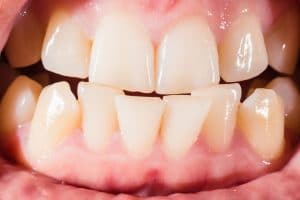Teeth grinding is one of the most common dental problems in children as well as adults. In fact, nearly 40% of children grind their teeth at some point. But when it comes to children, bruxism can be hard to identify.
To prevent damage to newly formed teeth, as well as jaw alignment, many parents opt to use pacifiers to allow their children something safe to suckle on, as well as prevent the formation of other dental issues.
What is a Pacifier?
A pacifier is essentially a rubber nipple on a handle that is designed to accommodate your baby’s urge to suckle. The suckling action can help calm—or pacify—an irritated or anxious baby.
Some signs that a pacifier might be appropriate for your baby include:
- continuing to suck on the baby bottle, even when it is empty
- becoming irritable when pulled away from feeding
- sucking on his fingers or thumbs
- sucking on blankets, toys and other objects
- grinding his teeth or gums, especially while sleeping
- signs of wearing to new teeth (appearing blunt, short or chipped)
Causes of Bruxism
Bruxism often occurs in children when when their baby teeth form, as well as when adult teeth come in. In this case, the grinding is triggered by the pain and growth of newly formed teeth. Some babies clench their jaws when they are teething, and continue the habit after the teeth have grown in.
In addition to teething, there are several potential causes of bruxism:
Stress
Stress is the most common reason behind teeth grinding, both in adults and children. As children might have difficulty identifying stressful triggers or lack the ability to discuss them, parents will need to do some detective work to figure out how to reduce their child’s stress.
Tension Headaches
Tension headaches are the most common type of headache. Like bruxism, tension headaches can have several underlying factors such as stress, lack of sleep, bad posture or hunger. Nearly half of children who have tension headaches also complain of bruxism.
Nasal obstruction
Nasal obstruction occurs when the sinuses are blocked due to swollen sinuses or a deviated septum. If you suspect your child is having difficulty breathing through his nose, a trip to the pediatrician is in order.
When to Introduce a Pacifier
Suckling is an instinctual habit that babies and young children exhibit, and is difficult to curb all together. Experts agree that using a pacifier is both normal and healthy for children at a certain frequency up to a certain age.
If you are bottle feeding, you can give your baby a pacifier right away. However, if you are breastfeeding, experts recommend waiting six weeks to introduce a pacifier to avoid confusion about which nipple actually provides nourishment.
Why Use a Pacifier?
The use of a pacifier can have several benefits.
- Reduces the likelihood of Sudden Infant Death Syndrome
- Reduces the frequency that babies suck on other objects (i.e. thumb sucking and placing foreign objects in their mouths). This is beneficial because non-sterile objects that babies place in their mouth can lead to the ingestion of harmful germs that can make them sick.
- Reduces bruxism, which helps prevent future dental issues.
- Reduces thumbsucking, which is a habit that dentists typically believe is worse than using pacifiers. Thumbs are harder surfaces and put more pressure on the front teeth.
Side Effects of Excessive or Prolonged Pacifier Use

Continued use of a pacifier or other methods of soothing (like thumbs or fingers) can cause alignment issues of the teeth and mouth structure that can lead to orthodontic treatment that includes braces. Long-term pacifier use can cause:
- Overbite (top front teeth jut out)
- Underbite (bottom front teeth to face inwards)
- Open bite (top and bottom teeth don’t overlap)
- Crooked teeth
- Top and bottom teeth not meeting when the mouth is closed
- Changes to the roof of the mouth
- Misalignment of upper and lower jaws
- The roof of the mouth to be narrower side to side
- Spacing
- Speech impediments
Drawbacks of Overuse
Protruding front teeth can become a serious dental issue for your child, as teeth that stick out are more prone to injury and other trauma. Due to their misaligned positions, they also may wear at different rates. Chronic pacifier use can cause teeth misalignment or problems with jaw development in children as young as between the ages of 2 and 4. Pacifiers also can increase the risk of ear infections. And some babies cry each time their pacifier falls out, including at night, which is no fun for the parents. The best way to use pacifiers is to limit them to certain locations and situations.
How to Introduce a Pacifier
Choose the Right Time
Set aside a time to introduce your baby to the pacifier. It should be after your baby has been fed but not too close to the next meal.
Before introducing the pacifier for the first time, consider your baby’s mood. Introduce the pacifier when your baby is feeling calm and content. If your infant is upset or crying, hold off until his mood improves.
Slowly But Surely
Unfortunately not all babies immediately take to a pacifier. They may require you to introduce the pacifier slowly over time. If your baby does not immediately begin to suckle on the pacifier, practice touching it to the baby’s cheek, a little ways back from the corner of the mouth.
Types of Pacifiers
Single Piece Pacifier
These pacifiers are a single unit made of plastic, silicone or latex. The appeal of single-piece pacifiers is that they do not come apart, which reduces the likelihood of the child breaking them, and, even more importantly, of swallowing or choking on small parts.
Multiple Piece Pacifier
The multi-piece pacifier contains three basic components. The nipple is placed inside the baby’s mouth, while the guard piece prevents him from sticking it in his mouth too far or swallowing it. The ring allows the child or parent to grip the pacifier.
Novelty Pacifiers
To make the experience more fun for kids and parents alike, a variety of novelty pacifiers exist on the market. These include pacifiers with plush stuffed animal guards, guards shaped in funny designs such as a moustache, and even pacifiers that glow in the dark.
Feeding Pacifiers
Once your baby is six months old, he is able to use a pacifier that will feed in addition to soothe. To use a feeding pacifier, freeze pieces of fruit and then place them in the pacifier’s detachable container. The flavor and the cool temperature often further help soothe any pain your child is experiencing, and the fruit provides a refreshing flavor.
Which Pacifier is Right for Your Child?
Though most pacifiers serve a similar function, there are a few things to consider when selecting the best one for your child.
Size
Baby pacifiers are sized by age group. These ages are generally:
- Six months or younger (Small)
- Six to 18 months (Medium)
- 18 months and older (Large)
How pacifier sizing works will vary by brand. Pay attention to the recommended age bracket on each specific brand of pacifier you consider. Using a pacifier that is not the right size for your child can lead to ineffectiveness, or even a choking hazard.
Nipple Material
The pacifier’s nipple may come in a variety of materials. The most popular material is silicone, as it is easy to clean either by hand or in the dishwasher, and retainers fewer odors than nipples made from other materials.
Latex is another popular option, as it is the most soft and flexible nipple material. Many babies prefer the flexibility of the latex, though it is more difficult to clean (latex pacifiers are generally not dishwasher safe) and wears down much faster.
Hard plastic is the least common nipple material, though it does have some benefits. Although it might not be as comfortable, the hard plastic is much more durable than other pacifier materials, and is very easy to clean either by hand or in the dishwasher.
Guard
The guard or shield should measure at least 1.5 inches. This prevents your baby from drawing the nipple too far into his mouth and choking.
Replacing Your Pacifier
Unfortunately, one pacifier does not last forever. Even if you are not ready to wean your baby off pacifiers altogether, you will need to recognize when to replace the one you are using with something new.
Signs that your baby’s pacifier needs replacing include:
- Holes or tears in the nipple.
- Discolored areas.
- Stretched nipple
- Plastic has turned jagged on guard or handle.
- A piece of the pacifier is loose.
- Nipple is sticky, even after thoroughly washing.
When to Stop Using the Pacifier
Many parents worry that their child could make the pacifier a habit that is hard to break. In fact, if you are moving away from the pacifier experts recommend doing it slowly over about six months. Begin by decreasing the daytime pacifier use, and eventually stop allowing it at night as well.
At each of Orthodontic Associates’ nine convenient locations in the Baltimore area, we are committed to your child’s overall dental health and hygiene. From when the teeth first form to when it’s time for braces, our expert staff can help you and your child through all phases of the dental journey, from teething to braces. Contact us today to see how we can help you or your child achieve the perfect smile.



